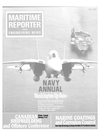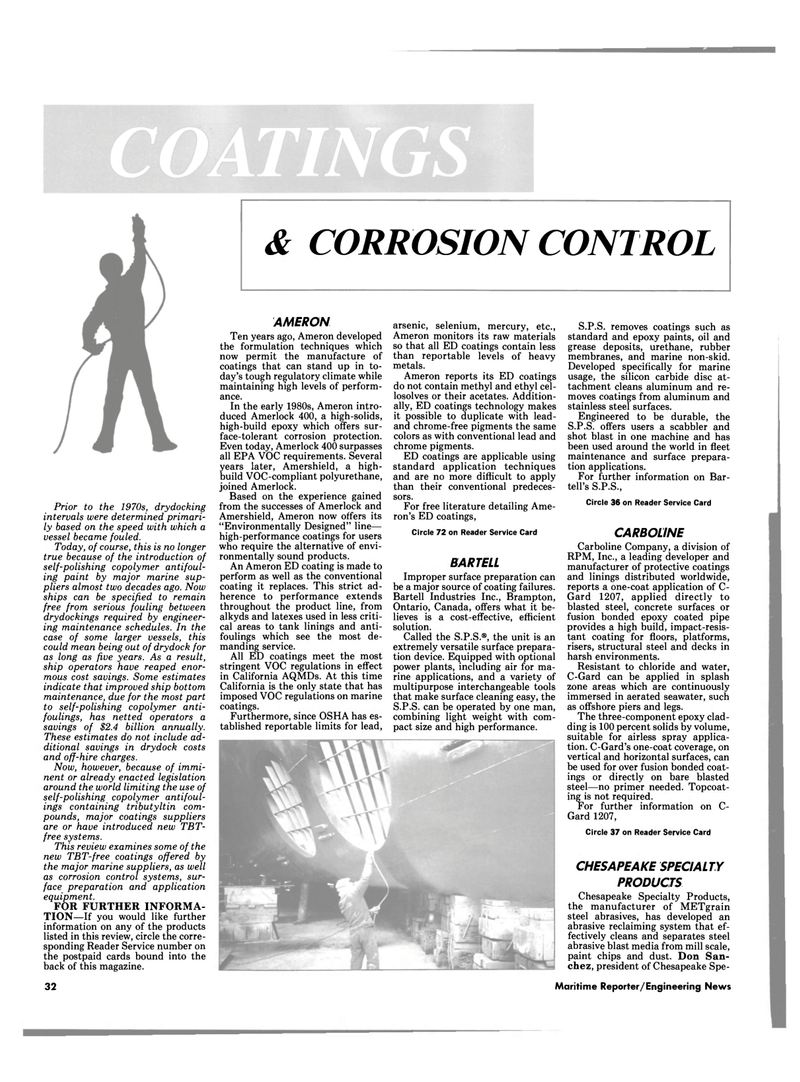
Page 30: of Maritime Reporter Magazine (February 1991)
Read this page in Pdf, Flash or Html5 edition of February 1991 Maritime Reporter Magazine
COATINGS
Prior to the 1970s, drydocking intervals were determined primari- ly based on the speed with which a vessel became fouled.
Today, of course, this is no longer true because of the introduction of self-polishing copolymer antifoul- ing paint by major marine sup- pliers almost two decades ago. Now ships can be specified to remain free from serious fouling between drydockings required by engineer- ing maintenance schedules. In the case of some larger vessels, this could mean being out of dry dock for as long as five years. As a result, ship operators have reaped enor- mous cost savings. Some estimates indicate that improved ship bottom maintenance, due for the most part to self-polishing copolymer anti- foulings, has netted operators a savings of $2.4 billion annually.
These estimates do not include ad- ditional savings in drydock costs and off-hire charges.
Now, however, because of immi- nent or already enacted legislation around the world limiting the use of self-polishing copolymer antifoul- ings containing tributyltin com- pounds, major coatings suppliers are or have introduced new TBT- free systems.
This review examines some of the new TBT-free coatings offered by the major marine suppliers, as well as corrosion control systems, sur- face preparation and application equipment.
FOR FURTHER INFORMA-
TION—If you would like further information on any of the products listed in this review, circle the corre- sponding Reader Service number on the postpaid cards bound into the back of this magazine. 32 & CORROSION CONTROL
CHESAPEAKE SPECIALTY
PRODUCTS
Chesapeake Specialty Products, the manufacturer of METgrain steel abrasives, has developed an abrasive reclaiming system that ef- fectively cleans and separates steel abrasive blast media from mill scale, paint chips and dust. Don San- chez, president of Chesapeake Spe-
Maritime Reporter/Engineering News
AMERON
Ten years ago, Ameron developed the formulation techniques which now permit the manufacture of coatings that can stand up in to- day's tough regulatory climate while maintaining high levels of perform- ance.
In the early 1980s, Ameron intro- duced Amerlock 400, a high-solids, high-build epoxy which offers sur- face-tolerant corrosion protection.
Even today, Amerlock 400 surpasses all EPA VOC requirements. Several years later, Amershield, a high- build VOC-compliant polyurethane, joined Amerlock.
Based on the experience gained from the successes of Amerlock and
Amershield, Ameron now offers its "Environmentally Designed" line— high-performance coatings for users who require the alternative of envi- ronmentally sound products.
An Ameron ED coating is made to perform as well as the conventional coating it replaces. This strict ad- herence to performance extends throughout the product line, from alkyds and latexes used in less criti- cal areas to tank linings and anti- foulings which see the most de- manding service.
All ED coatings meet the most stringent VOC regulations in effect in California AQMDs. At this time
California is the only state that has imposed VOC regulations on marine coatings.
Furthermore, since OSHA has es- tablished reportable limits for lead, arsenic, selenium, mercury, etc.,
Ameron monitors its raw materials so that all ED coatings contain less than reportable levels of heavy metals.
Ameron reports its ED coatings do not contain methyl and ethyl cel- losolves or their acetates. Addition- ally, ED coatings technology makes it possible to duplicate with lead- and chrome-free pigments the same colors as with conventional lead and chrome pigments.
ED coatings are applicable using standard application techniques and are no more difficult to apply than their conventional predeces- sors.
For free literature detailing Ame- ron's ED coatings,
Circle 72 on Reader Service Card
BARTELL
Improper surface preparation can be a major source of coating failures.
Bartell Industries Inc., Brampton,
Ontario, Canada, offers what it be- lieves is a cost-effective, efficient solution.
Called the S.P.S.®, the unit is an extremely versatile surface prepara- tion device. Equipped with optional power plants, including air for ma- rine applications, and a variety of multipurpose interchangeable tools that make surface cleaning easy, the
S.P.S. can be operated by one man, combining light weight with com- pact size and high performance.
S.P.S. removes coatings such as standard and epoxy paints, oil and grease deposits, urethane, rubber membranes, and marine non-skid.
Developed specifically for marine usage, the silicon carbide disc at- tachment cleans aluminum and re- moves coatings from aluminum and stainless steel surfaces.
Engineered to be durable, the
S.P.S. offers users a scabbier and shot blast in one machine and has been used around the world in fleet maintenance and surface prepara- tion applications.
For further information on Bar- tell's S.P.S.,
Circle 36 on Reader Service Card
CARBOLINE
Carboline Company, a division of
RPM, Inc., a leading developer and manufacturer of protective coatings and linings distributed worldwide, reports a one-coat application of C-
Gard 1207, applied directly to blasted steel, concrete surfaces or fusion bonded epoxy coated pipe provides a high build, impact-resis- tant coating for floors, platforms, risers, structural steel and decks in harsh environments.
Resistant to chloride and water,
C-Gard can be applied in splash zone areas which are continuously immersed in aerated seawater, such as offshore piers and legs.
The three-component epoxy clad- ding is 100 percent solids by volume, suitable for airless spray applica- tion. C-Gard's one-coat coverage, on vertical and horizontal surfaces, can be used for over fusion bonded coat- ings or directly on bare blasted steel—no primer needed. Topcoat- ing is not required.
For further information on C-
Gard 1207,
Circle 37 on Reader Service Card

 29
29

 31
31
